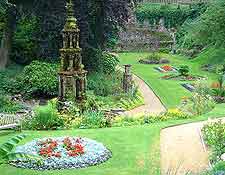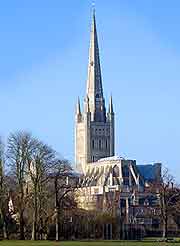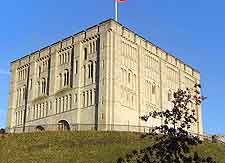Norwich History Facts and Timeline
(Norwich, Norfolk, England)

East Anglia has been occupied by various groups of people since the earliest times. Among them was the Iceni tribe. Their leader was the indomitable Celtic warrior, Queen Boudicca.
The site on which the present city of Norwich stands is not known to have been inhabited until after the Romans started their withdrawal, with one of these villages being known as Norwic. Over history, the villages began to join together, forming what we now know as Norwich. At its centre was the ancient crossroads of Tombland.
Early History
By the 9th century AD, there's evidence that Norwich had become a fortified town under mainly Anglo-Saxon control. When the Normans arrived here following the events of 1066, they discovered a thriving town that could boast 25 churches. The Normans were to radically alter the town's appearance, dismantling many buildings and replacing them with a castle and massive earthworks. In 1096, they also started work on a cathedral, using stone transported in from northern
France.
The town witnessed a great deal of disruption and conflict during the Middle Ages. In 1217, French Prince Louis captured Norwich Castle in an attempt to seize the English throne. Then, in 1266, another attack was made on the town, this time by rebellious barons. An influx of European religious groups, including the Dominicans, Franciscans and Carmelites, led to conflict between citizens and the Church over land ownership.

By way of contrast, the 14th century was a time of relative prosperity. More markets were set up and Norwich enjoyed the benefits of an expanding wool trade. In 1380, bailiffs and a committee of wealthy merchants known as the 'Twenty Four' were given the power to make and change local laws.
Early Modern City
By the early 16th century, Norwich had become an extremely wealthy town. Its fortunes were soon, however, to take a rapid downturn. Higher taxes, a decline in wool production, several major fires and the dissolution of the city's monasteries all took their toll. The situation was dire until religious persecution in the Low Countries persuaded a group of emigrant weavers to move to Norwich. By the end of the 17th century, around 10,000 people were employed in wool manufacturing.
The Georgian era of history brought new grand houses to Norwich, along with many public buildings, including the Theatre Royal, Shire House and Assembly House. There was even a paved area known as the Gentleman's Walk, where the fashionably dressed could enjoy a stroll.

From the 19th Century to the Present-Day
The city was linked with
London by rail in 1846. Two railway stations were opened - the Victoria Station and the City Station. In 1860, a new road was also built to provide better access. By this time, Norwich was no longer dependent on the wool trade. It had diversified into engineering, beer brewing, boot and shoe manufacture, and even mustard. Colman's mustard is still sold today.
The face of the city was to change once again with the arrival of a tram system. Buildings were demolished to allow its construction. It was to be a short-lived innovation, however, with its replacement by buses as early as 1935.
As was the case for many cities in England, Norwich was to suffer a great deal during World War Two. Incendiary bombs destroyed 35,000 houses in all. The 'City of Norwich Plan 1945' was launched at the end of hostilities. Although the grand scheme of redevelopment didn't come to fruition, the 1960s did bring some architectural changes to the city.
 East Anglia has been occupied by various groups of people since the earliest times. Among them was the Iceni tribe. Their leader was the indomitable Celtic warrior, Queen Boudicca.
East Anglia has been occupied by various groups of people since the earliest times. Among them was the Iceni tribe. Their leader was the indomitable Celtic warrior, Queen Boudicca. By way of contrast, the 14th century was a time of relative prosperity. More markets were set up and Norwich enjoyed the benefits of an expanding wool trade. In 1380, bailiffs and a committee of wealthy merchants known as the 'Twenty Four' were given the power to make and change local laws.
By way of contrast, the 14th century was a time of relative prosperity. More markets were set up and Norwich enjoyed the benefits of an expanding wool trade. In 1380, bailiffs and a committee of wealthy merchants known as the 'Twenty Four' were given the power to make and change local laws.